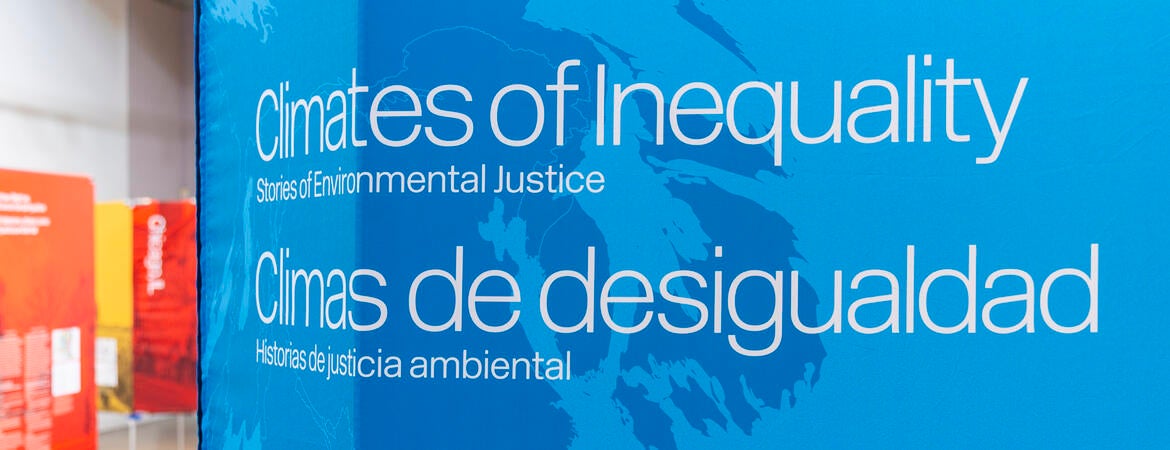College of Humanities, Arts, and Social Sciences

The Public History Program at UCR welcomed “Climates of Inequality: Stories of Environmental Justice,” a public initiative years in the making to Southern California, with installations of the traveling exhibition at the Japanese American National Museum in Los Angeles in September and at the Riverside Art Museum in October through November. This project marks the third exhibition in a series of traveling exhibitions, initiatives, and public programs that the Public History Program has actively engaged in with the Humanities Action Lab (HAL), a collaboration between students, faculty, and issues-based organizations, since 2011.
A robust set of public programming accompanied the exhibition at each of the regional stops. For the Riverside presentation, programming launched at UCR ARTS with a film screening and continued with all-ages events at the Riverside Art Museum, from Oct 14 through Nov 5.
The funded project, which began in fall 2017, is a joint effort involving HAL, UCR, the People’s Collective for Environmental Justice, and 21 other organizations across different localities. Led by Rutgers University-Newark, HAL collaborates with universities and issue organizations to create traveling public projects addressing pressing social issues.
“Climates of Inequality” is a participatory public memory project that unites students, educators, and community leaders to highlight the experiences of "frontline" communities disproportionately affected by the climate crisis. Over 500 students–from UCR and elsewhere–worked on the exhibition and programs.
Gudis joined “Climates of Inequality” with HAL alongside UCR history professor Megan Asaka in 2018. In their classes, Asaka and Gudis worked with students alongside community partners such as East Yard Communities for Environmental Justice, Warehouse Worker Resource Center, and the People’s Collective for Environmental Justice. They conducted extensive research and oral history interviews, shedding light on the impact of environmental injustices in Southern California, particularly within communities affected by the logistics industry. The project aimed to amplify these stories, inspire change, and foster resilience among these frontline communities. (Frontline communities are those that live in proximity to warehouses, railroads, and truck traffic, who are first and worst hit by impacts of related pollution and other harms.
“We focus on local stories that connect with global issues of climate and environmental justice,” said Catherine Gudis, a professor of history at UCR and director of the Public History program. The local focus, on the Los Angeles and Inland Empire sectors, went under the name “Witnessing the Slow Violence of the Supply Chain.”
Public programs galvanized dialogue among community members, who addressed the impacts of logistics, especially the encroachment of warehouses in residential neighborhoods and larger health concerns, and the advances they have made in coalition building and fostering intergenerational advocacy.
According to Gudis, the exhibition showcases the historical disparities in how climate change has impacted communities of color and the working class, while also highlighting how communities have used art, music, and storytelling to make change and start conversations and efforts for a more equitable future. This was conveyed by participants in public programs held at Riverside Art Museum such as “Environmental Justice in the I.E.: Community-based Practice in Art, Activism, and Community Journalism,” “Cultures of Environment,” and a workshop for educators from community groups, K-12, colleges, and universities to build pathways for students of all ages to enter Environmental Justice work.
The Climates of Inequality exhibit was launched at Rutgers University–Newark in 2019. Community partners and UCR students attended and presented at the symposium in Newark, with funding secured by the Andrew W. Mellon Foundation and the National Endowment for the Humanities (NEH).
In 2020, the Mellon Foundation awarded HAL $500,000 over three years to support “Climates of Inequality and the COVID Crisis: Building Leadership at Minority Serving Institutions.” This supported regional partners, grad students, and faculty involved in the project, to build climate leadership in the region and advance ongoing public engagement efforts.
In August 2023, the NEH awarded HAL $498,000 to support the “Climates of Inequality” Discussions initiative as part of the traveling exhibition to foster nationwide humanities-based conversations led by “frontline” or “environmental justice” communities, which bear the most significant climate change burdens due to enduring environmental racism. The humanities-based conversations will build upon the past two months of programming at JANM and RAM, to include additional community and educational workshops and another exhibition scheduled for April to August 2024, entitled LAND USE(D), co-curated by Gudis and RAM.
As an endowed term chair appointed in 2018, Gudis supports interdisciplinary research and learning within the humanities and social sciences disciplines as part of a $1.5 million donation by UCR alumni, Teresa and Byron Pollitt.
“I was lucky to hold a Teresa and Byron Pollitt Endowed Term Chair which allowed me to offer paid internships to students over the years, and present the exhibition last month in downtown Los Angeles at the Japanese American National Museum,” she said.
“Funding also ensured that all public programs were free to the public,” Gudis said. “This broadened our audience base, because we created different modes of expression and engagement: through film, conversation, art, teaching workshops, family-friendly activities, and bilingual presentations. This allowed us to foster our relationships with different community organizations and individuals--which we aim to continue in the coming months.
“What’s great about talking and learning from community members affected by this—including all of us, as students and faculty at UCR—is that we make bridges between people,” Gudis said.
To learn more about “Climates of Inequality” please visit climatesofinequality.org/.
For more information about the spring LAND USE(D) exhibit and public programs, please visit events.ucr.edu and riversideartmuseum.org/.